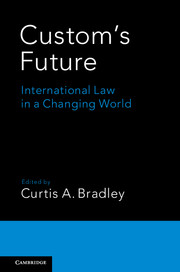Book contents
- Frontmatter
- Dedication
- Contents
- Notes on Contributors
- Introduction: Custom's Future
- 1 Custom's Past
- 2 Customary International Law Adjudication as Common Law Adjudication
- 3 Customary International Law as a Dynamic Process
- 4 Custom, Jus Cogens, and Human Rights
- 5 Customary International Law: How Do Courts Do It?
- 6 Custom's Method and Process: Lessons from Humanitarian Law
- 7 The Growing Obsolescence of Customary International Law
- 8 The Strange Vitality of Custom in the International Protection of Contracts, Property, and Commerce
- 9 The Decline of Customary International Law as a Source of International Criminal Law
- 10 Customary International Law and Public Goods
- 11 Reinvigorating Customary International Law
- 12 The Evolution of Codification: A Principal-Agent Theory of the International Law Commission's Influence
- 13 Custom and Informal International Lawmaking
- 14 Custom's Bright Future: The Continuing Importance of Customary International Law
- Bibliography
- Index
Introduction: Custom's Future
Published online by Cambridge University Press: 05 February 2016
- Frontmatter
- Dedication
- Contents
- Notes on Contributors
- Introduction: Custom's Future
- 1 Custom's Past
- 2 Customary International Law Adjudication as Common Law Adjudication
- 3 Customary International Law as a Dynamic Process
- 4 Custom, Jus Cogens, and Human Rights
- 5 Customary International Law: How Do Courts Do It?
- 6 Custom's Method and Process: Lessons from Humanitarian Law
- 7 The Growing Obsolescence of Customary International Law
- 8 The Strange Vitality of Custom in the International Protection of Contracts, Property, and Commerce
- 9 The Decline of Customary International Law as a Source of International Criminal Law
- 10 Customary International Law and Public Goods
- 11 Reinvigorating Customary International Law
- 12 The Evolution of Codification: A Principal-Agent Theory of the International Law Commission's Influence
- 13 Custom and Informal International Lawmaking
- 14 Custom's Bright Future: The Continuing Importance of Customary International Law
- Bibliography
- Index
Summary
Customary international law (CIL) is, along with treaties, one of the two principal sources of international law. Before the proliferation of treaty making in the twentieth century, CIL was the predominant source, regulating issues such as diplomatic immunity, rights at sea, and the conduct of war. In recent years, however, there have been increasing questions about CIL's continued relevance. Most areas of international law traditionally regulated by CIL are now also regulated by treaties. Treaties, moreover, have potential advantages as a source of law as compared with CIL: they are typically written, making their content easier to determine; they are expressly negotiated and ratified, making them more consensual; and they can be crafted with more precision, making them a potentially better vehicle for addressing the complexity of modern problems.
CIL is also subject to a variety of conceptual and evidentiary uncertainties. The conventional view today is that CIL arises out of state practice that is followed out of a sense of legal obligation. Agreement on this “two-element” definition of CIL, however, has the potential to obscure a lack of agreement over issues such as what constitutes state practice; how much state practice is enough; and what materials demonstrate a sense of legal obligation (also known as opinio juris). There is also little agreement about the extent to which treaties can serve as evidence of CIL, and about the role that non-state actors, including international institutions, can play in generating or confirming rules of CIL. In addition, the increasing resort by nations to “soft law” has raised new questions about the relationship between nonbinding norms and the development of CIL, and even about whether there should be a sharp distinction between nonbinding norms and CIL in an international system that relies heavily on informal methods of enforcement.
More generally, the two-element definition of CIL has itself faced substantial criticism. Part of the concern is normative: by tethering CIL so heavily to what states do, CIL is potentially too regressive, leaving little room for aspirational legal development. A different concern is empirical: there is suspicion that institutional actors may voice the two-element definition but do not actually follow it in practice. The two-element definition also implicates deeper jurisprudential questions about CIL as a source of law.
- Type
- Chapter
- Information
- Custom's FutureInternational Law in a Changing World, pp. 1 - 10Publisher: Cambridge University PressPrint publication year: 2016

